Tribological and Thermophysical Properties of Environmentally-Friendly Lubricants Based on Trimethylolpropane Trioleate with Hexagonal Boron Nitride Nanoparticles as an Additive
Abstract
:1. Introduction
2. Materials and Methods
2.1. Materials
2.2. Preparation of the Nanolubricants
2.3. Thermophysical and Rheological Characterization
2.4. Tribological Tests
3. Results and Discussion
3.1. Thermophysical and Rheological Characterization
3.2. Tribological Characterization
4. Conclusions
- Density slightly increased as the concentration of nanoparticles in the nanolubricant increased, up to 0.62%. Density values of the nanolubricants and TMPTO were successfully correlated as a function of both temperature and mass concentrations.
- The viscosity of the nanodispersions was higher than that of the neat oil, with the maximum increase being 9.2%. The nanolubricant with the highest nanoparticle concentration, 1.0 wt.%, showed non-Newtonian behavior at the lowest shear rates at 283.15 K.
- The best anti-friction and anti-wear capability was achieved with the 0.75 wt.% nanolubricant. Thus, reductions of 25% in the friction coefficient, 9% in the case of the wear scar, 14% of the scar depth, and 22% of the transversal area, were obtained with respect to the neat oil.
- h-BN was found by Raman spectroscopy in the worn surfaces tested with the nanolubricants. Polishing, mending and protective tribofilm effects were compatible with the results obtained with SEM, 3D profiler and Raman microscopy, as well as with the morphology of the h-BN nanoparticles.
Supplementary Materials
Author Contributions
Funding
Acknowledgments
Conflicts of Interest
References
- Gulzar, M.; Masjuki, H.H.; Kalam, M.A.; Varman, M.; Zulkifli, N.W.M.; Mufti, R.A.; Zahid, R. Tribological performance of nanoparticles as lubricating oil additives. J. Nanopart. Res. 2016, 18, 223. [Google Scholar] [CrossRef]
- Guo, D.; Xie, G.; Luo, J. Mechanical properties of nanoparticles: Basics and applications. J. Phys. D Appl. Phys. 2014, 47, 013001. [Google Scholar] [CrossRef]
- Shahnazar, S.; Bagheri, S.; Abd Hamid, S.B. Enhancing lubricant properties by nanoparticle additives. Int. J. Hydrogen Energy 2016, 41, 3153–3170. [Google Scholar] [CrossRef]
- Mia, M.; Gupta, M.K.; Singh, G.; Królczyk, G.; Pimenov, D.Y. An approach to cleaner production for machining hardened steel using different cooling-lubrication conditions. J. Clean. Prod. 2018, 187, 1069–1081. [Google Scholar] [CrossRef]
- Khan, A.M.; Jamil, M.; Salonitis, K.; Sarfraz, S.; Zhao, W.; He, N.; Mia, M.; Zhao, G. Multi-objective optimization of energy consumption and surface quality in nanofluid sqcl assisted face milling. Energies 2019, 12, 710. [Google Scholar] [CrossRef]
- Jamil, M.; Khan, A.M.; Hegab, H.; Gong, L.; Mia, M.; Gupta, M.K.; He, N. Effects of hybrid Al2O3-CNT nanofluids and cryogenic cooling on machining of Ti–6Al–4V. Int. J. Adv. Manuf. Technol. 2019, 102, 3895–3909. [Google Scholar] [CrossRef]
- Shtansky, D.V.; Firestein, K.L.; Golberg, D.V. Fabrication and application of BN nanoparticles, nanosheets and their nanohybrids. Nanoscale 2018, 10, 17477–17493. [Google Scholar] [CrossRef] [Green Version]
- Vuong, T.Q.P.; Liu, S.; Van der Lee, A.; Cuscó, R.; Artús, L.; Michel, T.; Valvin, P.; Edgar, J.H.; Cassabois, G.; Gil, B. Isotope engineering of van der Waals interactions in hexagonal boron nitride. Nat. Mater. 2017, 17, 152–158. [Google Scholar] [CrossRef] [Green Version]
- Kumari, S.; Sharma, O.P.; Gusain, R.; Mungse, H.P.; Kukrety, A.; Kumar, N.; Sugimura, H.; Khatri, O.P. Alkyl-Chain-Grafted Hexagonal Boron Nitride Nanoplatelets as Oil-Dispersible Additives for Friction and Wear Reduction. ACS Appl. Mater. Interfaces 2015, 7, 3708–3716. [Google Scholar] [CrossRef]
- Podgornik, B.; Kosec, T.; Kocijan, A.; Donik, Č. Tribological behaviour and lubrication performance of hexagonal boron nitride (h-BN) as a replacement for graphite in aluminium forming. Tribol. Int. 2015, 81, 267–275. [Google Scholar] [CrossRef]
- Lipp, A.; Schwetz, K.A.; Hunold, K. Hexagonal boron nitride: Fabrication, properties and applications. J. Eur. Ceram. Soc. 1989, 5, 3–9. [Google Scholar] [CrossRef]
- Shah, F.U.; Glavatskih, S.; Antzutkin, O.N. Boron in tribology: From borates to ionic liquids. Tribol. Lett. 2013, 51, 281–301. [Google Scholar] [CrossRef]
- Ay, G.M.; Göncü, Y.; Ay, N. Environmentally friendly material: Hexagonal boron nitride. J. Boron 2016, 1, 66–73. [Google Scholar]
- Mosleh, M.; Atnafu, N.D.; Belk, J.H.; Nobles, O.M. Modification of sheet metal forming fluids with dispersed nanoparticles for improved lubrication. Wear 2009, 267, 1220–1225. [Google Scholar] [CrossRef]
- Çelik, O.N.; Ay, N.; Göncü, Y. Effect of nano hexagonal boron nitride lubricant additives on the friction and wear properties of AISI 4140 steel. Part. Sci. Technol. 2013, 31, 501–506. [Google Scholar] [CrossRef]
- Wan, Q.; Jin, Y.; Sun, P.; Ding, Y. Tribological behaviour of a lubricant oil containing boron nitride nanoparticles. Procedia Eng. 2015, 102, 1038–1045. [Google Scholar] [CrossRef]
- Reeves, C.J.; Menezes, P.L.; Lovell, M.R.; Jen, T.-C. The size effect of boron nitride particles on the tribological performance of biolubricants for energy conservation and sustainability. Tribol. Lett. 2013, 51, 437–452. [Google Scholar] [CrossRef]
- Reeves, C.J.; Menezes, P.L.; Lovell, M.R.; Jen, T.-C. The influence of surface roughness and particulate size on the tribological performance of bio-based multi-functional hybrid lubricants. Tribol. Int. 2015, 88, 40–55. [Google Scholar] [CrossRef]
- Reeves, C.J.; Menezes, P.L. Evaluation of boron nitride particles on the tribological performance of avocado and canola oil for energy conservation and sustainability. Int. J. Adv. Manuf. Technol. 2017, 89, 3475–3486. [Google Scholar] [CrossRef]
- Charoo, M.S.; Wani, M.F. Tribological properties of h-BN nanoparticles as lubricant additive on cylinder liner and piston ring. Lubr. Sci. 2017, 29, 241–254. [Google Scholar] [CrossRef]
- Abdullah, M.I.H.C.; Abdollah, M.F.B.; Tamaldin, N.; Amiruddin, H.; Nuri, N.R.M. Effect of hexagonal boron nitride nanoparticles as an additive on the extreme pressure properties of engine oil. Ind. Lubr. Tribol. 2016, 68, 441–445. [Google Scholar] [CrossRef]
- Bondarev, A.V.; Kovalskii, A.M.; Firestein, K.L.; Loginov, P.A.; Sidorenko, D.A.; Shvindina, N.V.; Sukhorukova, I.V.; Shtansky, D.V. Hollow spherical and nanosheet-base BN nanoparticles as perspective additives to oil lubricants: Correlation between large-scale friction behavior and in situ TEM compression testing. Ceram. Int. 2018, 44, 6801–6809. [Google Scholar] [CrossRef]
- Zhang, W.; Cao, Y.; Tian, P.; Guo, F.; Tian, Y.; Zheng, W.; Ji, X.; Liu, J. Soluble, exfoliated two-dimensional nanosheets as excellent aqueous lubricants. ACS Appl. Mater. Interfaces 2016, 8, 32440–32449. [Google Scholar] [CrossRef] [PubMed]
- Liñeira del Río, J.M.; Guimarey, M.J.G.; Comuñas, M.J.P.; López, E.R.; Amigo, A.; Fernández, J. Thermophysical and tribological properties of dispersions based on graphene and a trimethylolpropane trioleate oil. J. Mol. Liq. 2018, 268, 854–866. [Google Scholar] [CrossRef]
- Beran, E.; Łoś, M.; Kmiecik, A. Influence of thermo-oxidative degradation on the biodegradability of lubricant base oils. J. Synth. Lubr. 2008, 25, 75–83. [Google Scholar] [CrossRef]
- Qiao, S.; Shi, Y.; Wang, X.; Lin, Z.; Jiang, Y. Synthesis of biolubricant trimethylolpropane trioleate and its lubricant base oil properties. Energy Fuels 2017, 31, 7185–7190. [Google Scholar] [CrossRef]
- Young, A.; Bair, S. Experimental investigation of friction in entrapped elastohydrodynamic contacts. Tribol. Int. 2010, 43, 1615–1619. [Google Scholar] [CrossRef]
- Wu, Y.; Li, W.; Zhang, M.; Wang, X. Improvement of oxidative stability of trimethylolpropane trioleate lubricant. Thermochim. Acta 2013, 569, 112–118. [Google Scholar] [CrossRef]
- Chang, T.S.; Yunus, R.; Rashid, U.; Choong, T.S.Y.; Biak, D.R.A.; Syam, A.M. Palm oil derived trimethylolpropane triesters synthetic lubricants and usage in industrial metalworking fluid. J. Oleo Sci. 2015, 64, 143–151. [Google Scholar] [CrossRef]
- Shashidhara, Y.M.; Jayaram, S.R. Vegetable oils as a potential cutting fluid-An evolution. Tribol. Int. 2010, 43, 1073–1081. [Google Scholar] [CrossRef]
- Cai, Q.; Scullion, D.; Gan, W.; Falin, A.; Zhang, S.; Watanabe, K.; Taniguchi, T.; Chen, Y.; Santos, E.J.G.; Li, L.H. High thermal conductivity of high-quality monolayer boron nitride and its thermal expansion. Sci. Adv. 2019, 5, eaav0129. [Google Scholar] [CrossRef] [PubMed] [Green Version]
- Aradi, E.; Naidoo, S.R.; Billing, D.G.; Wamwangi, D.; Motochi, I.; Derry, T.E. Ion beam modification of the structure and properties of hexagonal boron nitride: An infrared and X-ray diffraction study. Nucl. Instrum. Methods Phys. Res. B 2014, 331, 140–143. [Google Scholar] [CrossRef]
- Pillari, L.K.; Umasankar, V.; Elamathi, P.; Chandrasekar, G. Synthesis and characterization of nano hexagonal boron nitride powder and evaluating the influence on aluminium alloy matrix. Mater. Today Proc. 2016, 3, 2018–2026. [Google Scholar] [CrossRef]
- Fakrach, B.; Rahmani, A.; Chadli, H.; Sbai, K.; Bentaleb, M.; Bantignies, J.-L.; Sauvajol, J.-L. Infrared spectrum of single-walled boron nitride nanotubes. Phys. Rev. B 2012, 85, 115437. [Google Scholar] [CrossRef]
- Novotny-Farkas, F.; Böhme, W.; Stabinger, H.; Belitsch, W. The Stabinger Viscometer a New and Unique Instrument for Oil Service Laboratories; World Tribology Congress II; Anton Paar: Vienna, Austria, 2001. [Google Scholar]
- Paredes, X.; Fandiño, O.; Comuñas, M.J.P.; Pensado, A.S.; Fernández, J. Study of the effects of pressure on the viscosity and density of diisodecyl phthalate. J. Chem. Thermodyn. 2009, 41, 1007–1015. [Google Scholar] [CrossRef]
- Gaciño, F.M.; Regueira, T.; Lugo, L.; Comuñas, M.J.P.; Fernández, J. Influence of molecular structure on densities and viscosities of several ionic liquids. J. Chem. Eng. Data 2011, 56, 4984–4999. [Google Scholar] [CrossRef]
- ASTM D2270 Standard Practice for Calculating Viscosity Index from Kinematic Viscosity at 40 and 100 °C; ASTM International: West Conshohocken, PA, USA, 2016.
- Cabaleiro, D.; Pastoriza-Gallego, M.J.; Gracia-Fernández, C.; Piñeiro, M.M.; Lugo, L. Rheological and volumetric properties of TiO2-ethylene glycol nanofluids. Nanoscale Res. Lett. 2013, 8, 286. [Google Scholar] [CrossRef] [PubMed]
- Cabaleiro, D.; Pastoriza-Gallego, M.J.; Piñeiro, M.M.; Lugo, L. Characterization and measurements of thermal conductivity, density and rheological properties of zinc oxide nanoparticles dispersed in (ethane-1,2-diol+water) mixture. J. Chem. Thermodyn. 2013, 58, 405–415. [Google Scholar] [CrossRef]
- Otero, I.; López, E.R.; Reichelt, M.; Fernández, J. Friction and anti-wear properties of two tris (pentafluoroethyl) trifluorophosphate ionic liquids as neat lubricants. Tribol. Int. 2014, 70, 104–111. [Google Scholar] [CrossRef]
- Nair, R.P.; Griffin, D.; Randall, N.X. The use of the pin-on-disk tribology test method to study three unique industrial applications. Wear 2009, 267, 823–827. [Google Scholar] [CrossRef]
- Ren, S.; Huang, J.; Cui, M.; Pu, J.; Wang, L. Improved adaptability of polyaryl-ether-ether-ketone with texture pattern and graphite-like carbon film for bio-tribological applications. Appl. Surf. Sci. 2017, 400, 24–37. [Google Scholar] [CrossRef]
- Xie, H.; Jiang, B.; Hu, X.; Peng, C.; Guo, H.; Pan, F. Synergistic Effect of MoS2 and SiO2 nanoparticles as lubricant additives for magnesium alloy–steel contacts. Nanomaterials 2017, 7, 154. [Google Scholar] [CrossRef]
- Plint, G. The Sliding Hertzian Point Contact in Tribotesting: Understanding its Limitations as a Model of Real Systems. In Proceedings of the STLE 70th Annual Meeting and Exhibition, Dallas, TX, USA, 17–21 May 2015. [Google Scholar]
- Farsadi, M.; Bagheri, S.; Ismail, N.A. Nanocomposite of functionalized graphene and molybdenum disulfide as friction modifier additive for lubricant. J. Mol. Liq. 2017, 244, 304–308. [Google Scholar] [CrossRef]
- Guo, Y.-B.; Zhang, S.-W. The Tribological Properties of Multi-Layered Graphene as Additives of PAO2 oil in steel–steel contacts. Lubricants 2016, 4, 30. [Google Scholar] [CrossRef]
- Gupta, B.; Kumar, N.; Panda, K.; Dash, S.; Tyagi, A.K. Energy efficient reduced graphene oxide additives: Mechanism of effective lubrication and antiwear properties. Sci. Rep. 2016, 6, 18372. [Google Scholar] [CrossRef] [Green Version]
- Kiu, S.S.K.; Yusup, S.; Chok, V.S.; Taufiq, A.; Kamil, R.N.M.; Syahrullail, S.; Chin, B.L.F. Comparison on tribological properties of vegetable oil upon addition of carbon based nanoparticles. Mater. Sci. Eng. 2017, 206, 012043. [Google Scholar] [CrossRef] [Green Version]
- Liu, L.; Fang, Z.; Gu, A.; Guo, Z. Lubrication effect of the paraffin oil filled with functionalized multiwalled carbon nanotubes for bismaleimide resin. Tribol. Lett. 2011, 42, 59–65. [Google Scholar] [CrossRef]
- Liu, Z.; Wei, H.; Tang, B.; Xu, S.; Shufen, Z. Novel light–driven CF/PEG/SiO2 composite phase change materials with high thermal conductivity. Sol. Energy Mater. Sol. Cells 2018, 174, 538–544. [Google Scholar] [CrossRef]
- Wu, L.; Gu, L.; Xie, Z.; Zhang, C.; Song, B. Improved tribological properties of Si3N4/GCr15 sliding pairs with few layer graphene as oil additives. Ceram. Int. 2017, 43, 14218–14224. [Google Scholar] [CrossRef]
- Zin, V.; Barison, S.; Agresti, F.; Colla, L.; Pagura, C.; Fabrizio, M. Improved tribological and thermal properties of lubricants by graphene based nano-additives. RSC Adv. 2016, 6, 59477–59486. [Google Scholar] [CrossRef]
- Liñeira del Río, J.M.; López, E.R.; Fernández, J.; García, F. Tribological properties of dispersions based on reduced graphene oxide sheets and trimethylolpropane trioleate or PAO 40 oils. J. Mol. Liq. 2019, 274, 568–576. [Google Scholar] [CrossRef]
- Tang, Z.; Li, S. A review of recent developments of friction modifiers for liquid lubricants (2007–present). Curr. Opin. Solid State Mater. Sci. 2014, 18, 119–139. [Google Scholar] [CrossRef]
- Ali, M.K.A.; Xianjun, H.; Essa, F.A.; Abdelkareem, M.A.A.; Elagouz, A.; Sharshir, S.W. Friction and wear reduction mechanisms of the reciprocating contact interfaces using nanolubricant under different loads and speeds. J. Tribol. 2018, 140, 051606. [Google Scholar]
- Lv, J.; Bai, M.; Cui, W.; Li, X. The molecular dynamic simulation on impact and friction characters of nanofluids with many nanoparticles system. Nanoscale Res. Lett. 2011, 6, 200. [Google Scholar] [CrossRef]
- Kogovšek, J.; Remškar, M.; Mrzel, A.; Kalin, M. Influence of surface roughness and running-in on the lubrication of steel surfaces with oil containing MoS2 nanotubes in all lubrication regimes. Tribol. Int. 2013, 61, 40–47. [Google Scholar] [CrossRef]
- Binu, K.G.; Shenoy, B.S.; Rao, D.; Pai, R. A variable viscosity approach for the evaluation of load carrying capacity of oil lubricated journal bearing with TiO2 nanoparticles as lubricant additives. Procedia Mater. Sci. 2014, 6, 1051–1067. [Google Scholar] [CrossRef]
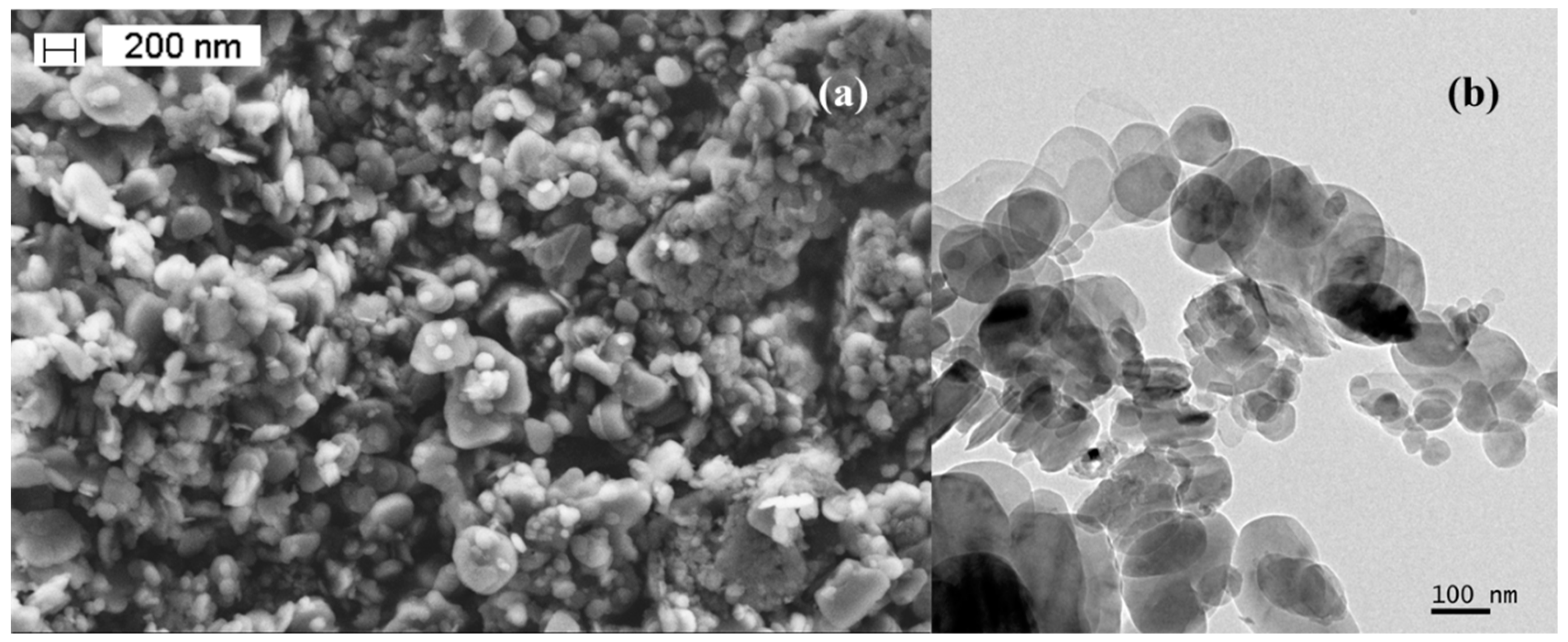


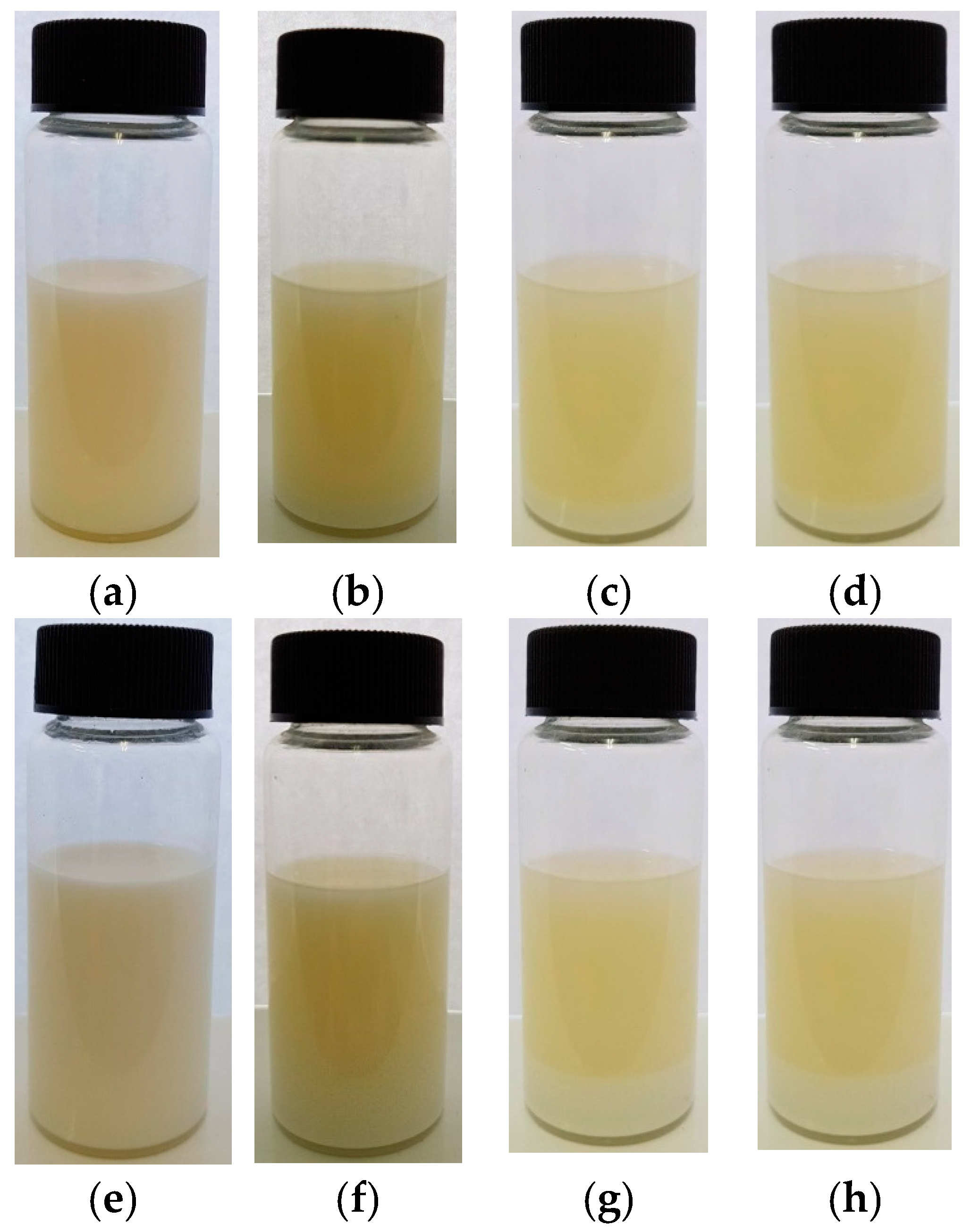
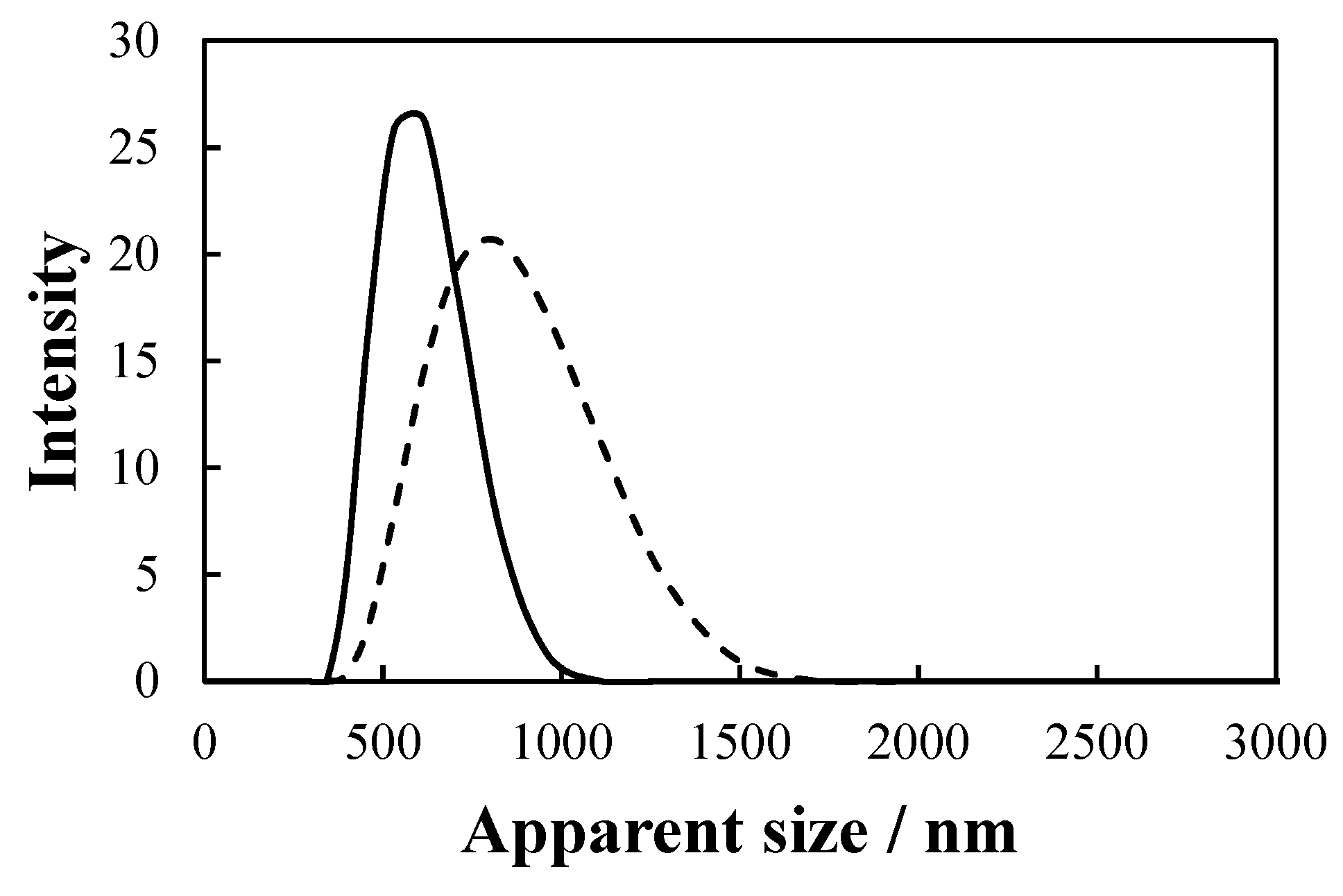

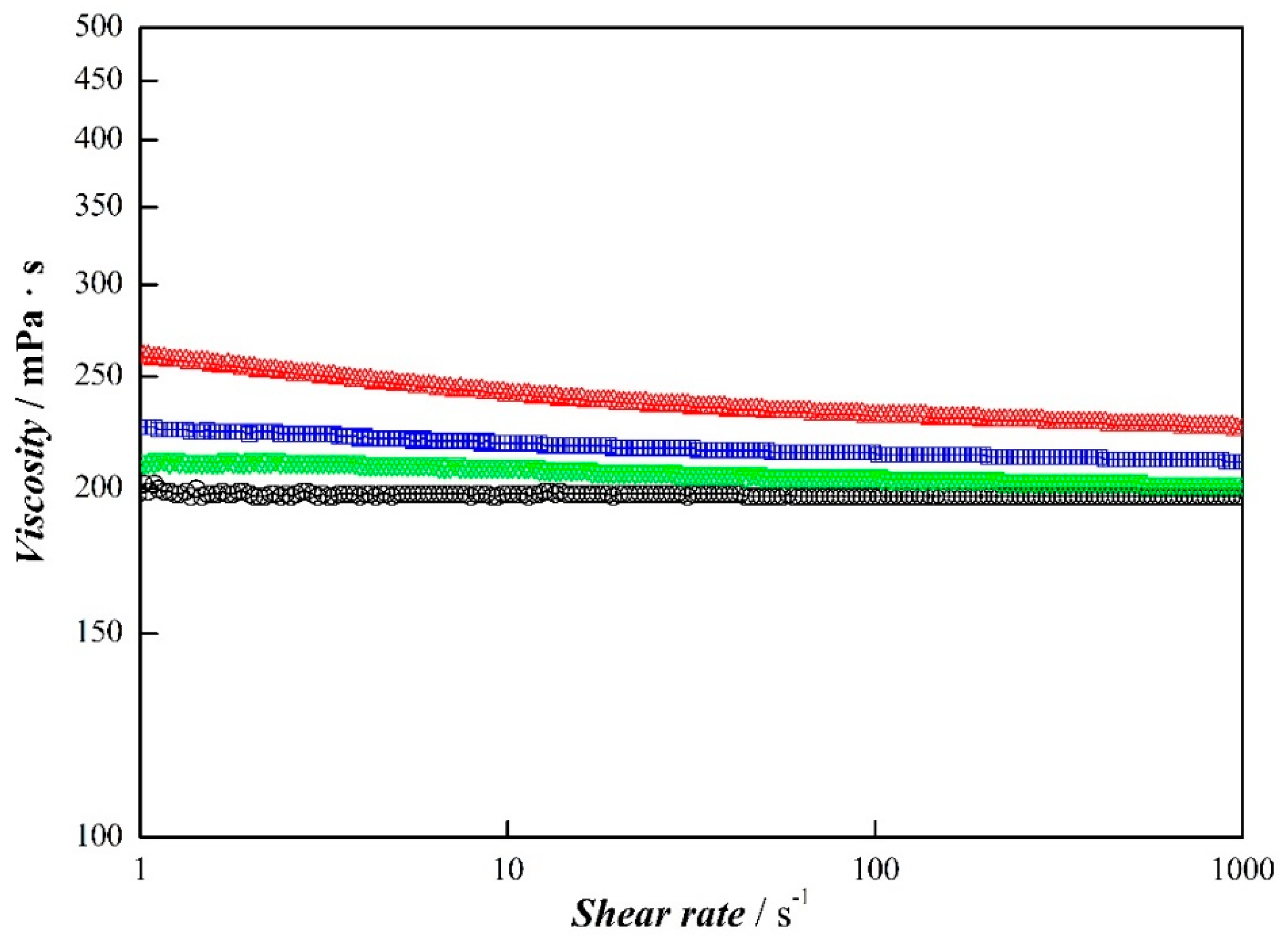

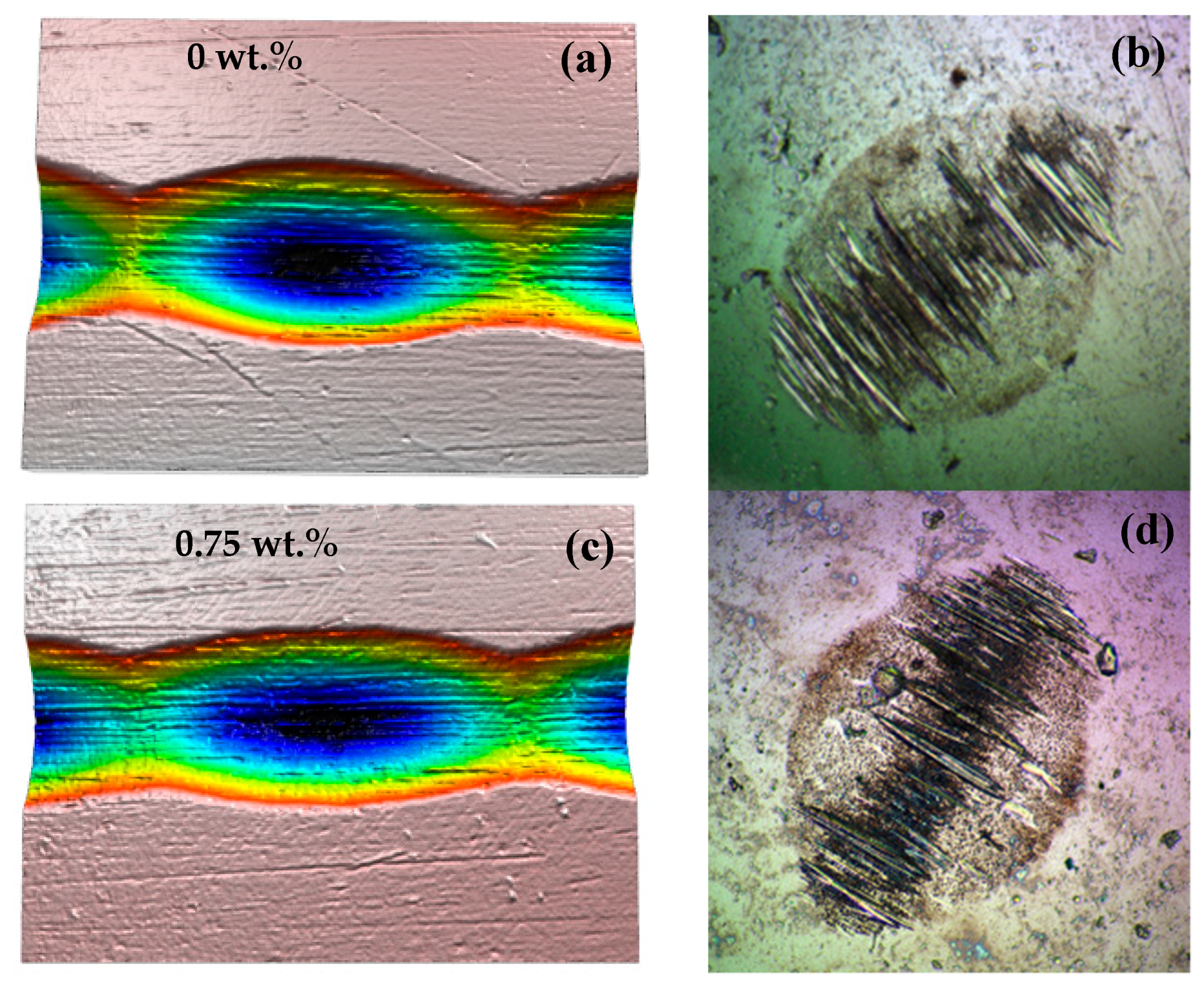
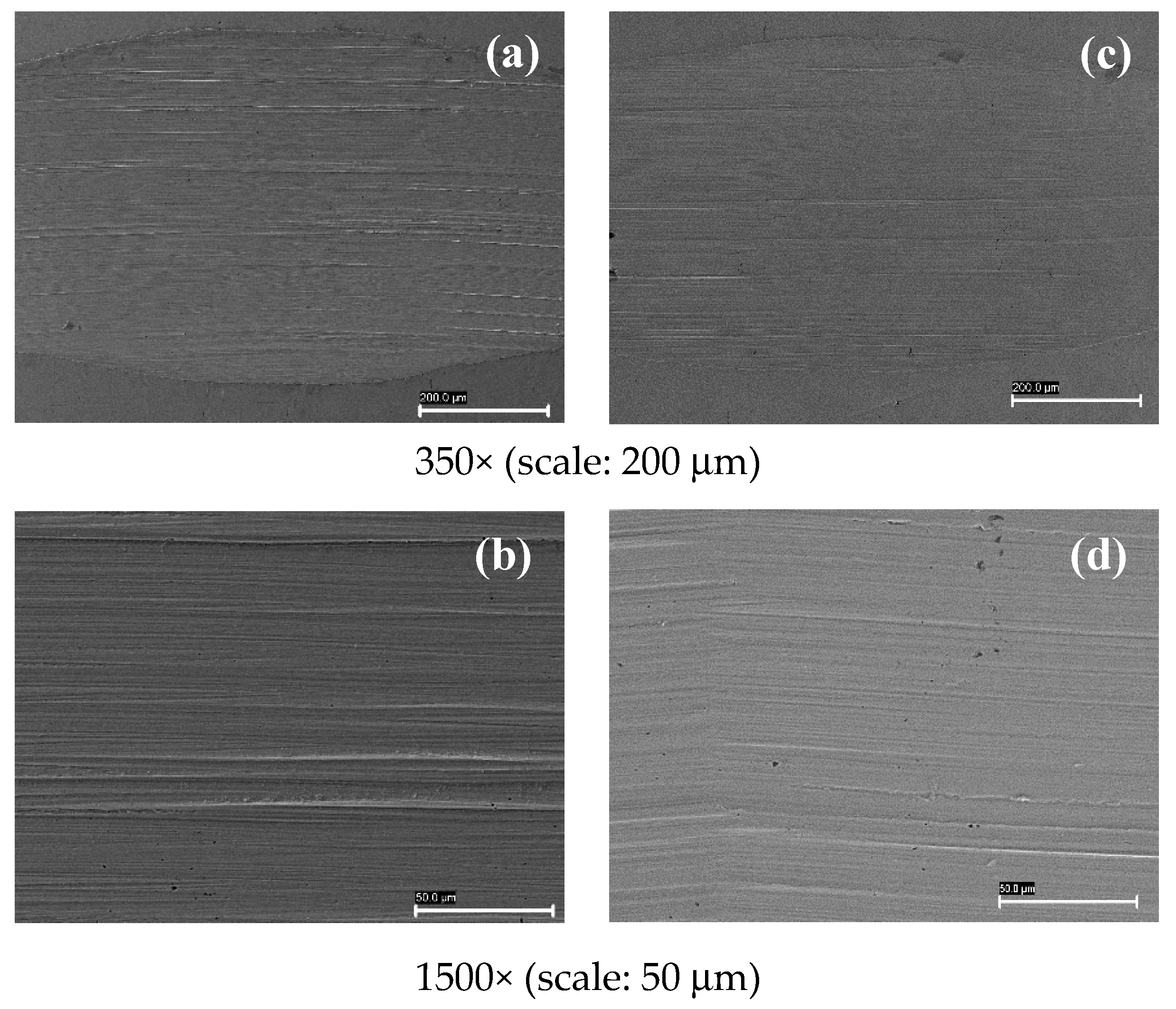

| T/K | ρ/g cm−3 | ||
|---|---|---|---|
| 0.50 wt.% h-BN/TMPTO | 0.75 wt.% h-BN/TMPTO | 1.0 wt.% h-BN/TMPTO | |
| 278.15 | 0.9295 | 0.9310 | 0.9318 |
| 283.15 | 0.9263 | 0.9278 | 0.9286 |
| 288.15 | 0.9230 | 0.9245 | 0.9253 |
| 293.15 | 0.9198 | 0.9213 | 0.9221 |
| 298.15 | 0.9166 | 0.9181 | 0.9189 |
| 303.15 | 0.9133 | 0.9148 | 0.9157 |
| 308.15 | 0.9101 | 0.9116 | 0.9124 |
| 313.15 | 0.9068 | 0.9083 | 0.9092 |
| 318.15 | 0.9036 | 0.9051 | 0.9059 |
| 323.15 | 0.9003 | 0.9018 | 0.9027 |
| 328.15 | 0.8970 | 0.8985 | 0.8995 |
| 333.15 | 0.8937 | 0.8952 | 0.8962 |
| 338.15 | 0.8904 | 0.8920 | 0.8929 |
| 343.15 | 0.8872 | 0.8887 | 0.8897 |
| 348.15 | 0.8839 | 0.8854 | 0.8864 |
| 353.15 | 0.8806 | 0.8821 | 0.8831 |
| 358.15 | 0.8773 | 0.8788 | 0.8798 |
| 363.15 | 0.8741 | 0.8756 | 0.8766 |
| 368.15 | 0.8708 | 0.8723 | 0.8733 |
| 373.15 | 0.8676 | 0.8691 | 0.8701 |
| T/K | η/mPa·s | ||
|---|---|---|---|
| 0.50 wt.% h-BN/TMPTO | 0.75 wt.% h-BN/TMPTO | 1.0 wt.% h-BN/TMPTO | |
| 278.15 | 260.5 | 266.7 | 263.9 |
| 283.15 | 193.6 | 198.2 | 196.5 |
| 288.15 | 147.0 | 150.5 | 149.4 |
| 293.15 | 113.6 | 116.2 | 115.6 |
| 298.15 | 89.25 | 91.24 | 90.88 |
| 303.15 | 71.21 | 72.76 | 72.56 |
| 308.15 | 57.63 | 58.88 | 58.74 |
| 313.15 | 47.27 | 48.29 | 48.20 |
| 318.15 | 39.25 | 40.11 | 40.06 |
| 323.15 | 32.96 | 33.70 | 33.71 |
| 328.15 | 27.98 | 28.63 | 28.69 |
| 333.15 | 23.99 | 24.56 | 24.66 |
| 338.15 | 20.74 | 21.25 | 21.37 |
| 343.15 | 18.07 | 18.53 | 18.67 |
| 348.15 | 15.87 | 16.29 | 16.42 |
| 353.15 | 14.03 | 14.42 | 14.54 |
| 358.15 | 12.48 | 12.83 | 12.93 |
| 363.15 | 11.16 | 11.48 | 11.52 |
| 368.15 | 10.04 | 10.32 | 10.34 |
| 373.15 | 9.069 | 9.300 | 9.352 |
| Parameter | Value |
|---|---|
| A/g·cm−3 | 1.1079 ± 0.0003 |
| −104 B/g·cm−3·K−1 | 6.518 ± 0.009 |
| 103 C/ g·cm−3 | 5.65 ± 0.07 |
| σ/g·cm−3 | 0.0002 |
| TMPTO + h-BN | ||||||||
|---|---|---|---|---|---|---|---|---|
| wt.% | µ | σ | WTW/μm | σ/μm | WTD/μm | σ/μm | Area/μm2 | σ/μm2 |
| 0 | 0.1632 | 0.0011 | 579 | 14 | 14.02 | 0.22 | 5470 | 180 |
| 0.50 | 0.1234 | 0.0012 | 579 | 18 | 13.67 | 0.31 | 5340 | 180 |
| 0.75 | 0.1221 | 0.0008 | 529 | 15 | 12.11 | 0.19 | 4260 | 160 |
| 1.0 | 0.1303 | 0.0014 | 611 | 19 | 15.12 | 0.34 | 6110 | 190 |
© 2019 by the authors. Licensee MDPI, Basel, Switzerland. This article is an open access article distributed under the terms and conditions of the Creative Commons Attribution (CC BY) license (http://creativecommons.org/licenses/by/4.0/).
Share and Cite
Liñeira del Río, J.M.; Guimarey, M.J.G.; Comuñas, M.J.P.; López, E.R.; Prado, J.I.; Lugo, L.; Fernández, J. Tribological and Thermophysical Properties of Environmentally-Friendly Lubricants Based on Trimethylolpropane Trioleate with Hexagonal Boron Nitride Nanoparticles as an Additive. Coatings 2019, 9, 509. https://doi.org/10.3390/coatings9080509
Liñeira del Río JM, Guimarey MJG, Comuñas MJP, López ER, Prado JI, Lugo L, Fernández J. Tribological and Thermophysical Properties of Environmentally-Friendly Lubricants Based on Trimethylolpropane Trioleate with Hexagonal Boron Nitride Nanoparticles as an Additive. Coatings. 2019; 9(8):509. https://doi.org/10.3390/coatings9080509
Chicago/Turabian StyleLiñeira del Río, José M., María J. G. Guimarey, María J. P. Comuñas, Enriqueta R. López, Jose I. Prado, Luis Lugo, and Josefa Fernández. 2019. "Tribological and Thermophysical Properties of Environmentally-Friendly Lubricants Based on Trimethylolpropane Trioleate with Hexagonal Boron Nitride Nanoparticles as an Additive" Coatings 9, no. 8: 509. https://doi.org/10.3390/coatings9080509








